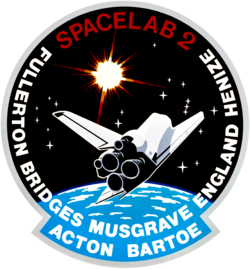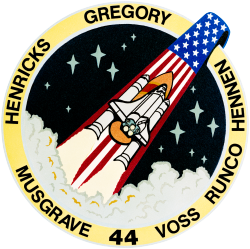Story Musgrave
| Story Musgrave | |
 | |
| NASA-astronaut | |
|---|---|
| Tillstånd | Ej aktiv |
| Född | 19 augusti 1935 Boston, Massachusetts, USA |
| Tidigare yrke | Läkare, kirurg |
| Tid i rymden | 53 dagar, 9 timmar, 55 minuter |
| Urvalsgrupp | Astronautgrupp 6, den 4 augusti 1967 |
| Antal rymdpromenader | 4 |
| Rymdpromenadtid | 26 timmar, 19 minuter |
| Uppdrag | STS‑6, STS‑51‑F, STS‑33, STS‑44, STS‑61, STS‑80 |
| Uppdragsemblem | |
Franklin Story Musgrave, född 19 augusti 1935 i Boston, Massachusetts, är en amerikansk astronaut uttagen i astronautgrupp 6 den 4 augusti 1967.
Karriär
Han tjänstgjorde som kommunikationsansvarig (CAPCOM, en benämning som lever kvar från tidigare NASAuppdrag och står för CAPsule COMmunicator) mellan markkontrollen och rymdfärjan i uppdragen STS-31, STS-35, STS-36, STS-38 och STS-41, en roll som han även spelade i sin skådespelardebut i filmen Mission to Mars.
Rymdfärder
Källor
”Biographical Data” (på engelska) (PDF). NASA. augusti 1997. https://www.nasa.gov/wp-content/uploads/2016/01/musgrave_story.pdf?emrc=c81d9c. Läst 16 november 2024.
|
Media som används på denna webbplats
STS-61 Crew Insignia
STS-33 Mission Insignia
STS-51F Mission Insignia
- The crewmembers of Space Shuttle mission 51-F have chosen as their insignia this design by Houston artist Skip Bradley. The Space Shuttle Challenger is depicted ascending toward the heavens in search of new knowledge in the field of solar and stellar astronomy, with its Spacelab 2 payload. The constellations Leo and Orion are in the positions they will be in, relative to the sun during the flight. The nineteen stars signify that this will be the 19th STS flight. Crewmembers for the mission are Astronauts C. Gordon Fullerton, commander; Roy D. Bridges, pilot; F. Story Musgrave, Anthony W. England, and Karl J. Henize, mission specialist; and Payload Specialists Loren W. Acton and John David Bartoe.
This mission patch for mission STS-80 depicts the Space Shuttle Columbia and the two research satellites its crew deployed into the blue field of space. The uppermost satellite is the Orbiting Retrievable Far and Extreme Ultraviolet Spectrograph-Shuttle Pallet Satellite (ORFEUS-SPAS), a telescope aimed at unraveling the life cycles of stars and understanding the gases that drift between them. The lower satellite is the Wake Shield Facility (WSF), flying for the third time. It will use the vacuum of space to create advanced semiconductors for the nation's electronics industry. ORFEUS and WSF are joined by the symbol of the Astronaut Corps, representing the human contribution to scientific progress in space. The two bright blue stars represent the mission's Extravehicular Activities (EVA), final rehearsals for techniques and tools to be used in assembly of the International Space Station (ISS). Surrounding Columbia is a constellation of 16 stars, one for each day of the mission, representing the stellar talents of the ground and flight teams that share the goal of expanding knowledge through a permanent human presence in space.
STS-6 Crew Insignia
Story Musgrave (M.D.), NASA Astronaut
STS-44 Mission Insignia






